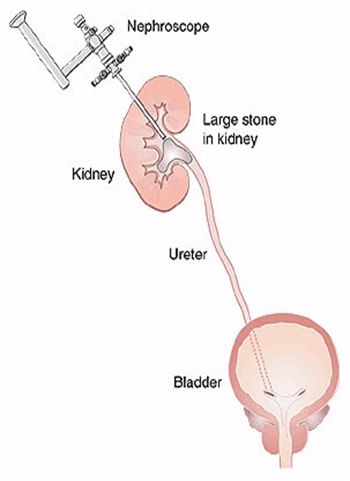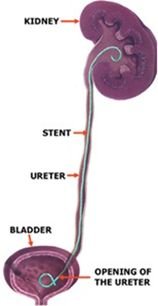Percutaneous Nephrolithotomy
Percutaneous Nephrolithotomy (PCNL)
What is Percutaneous Nephrolithotomy (PCNL)?
Percutaneous Nephrolithotomy (PCNL) is the preferred technique for treating large stones within the kidney. It involves keyhole surgery performed through a 1cm incision in the kidney’s skin overlying (see diagram).

WHAT ARE THE ADVANTAGES?
- Allows large or complicated stones to be treated minimally invasively, whereas, in the past, this would have necessitated a large skin incision.
- Hospital stay is 3-4 days, and out-of-hospital recovery time is significantly shorter than traditional open surgery.
- Compared to conventional treatments of large complex stones, there are no disadvantages. Improved techniques and equipment have allowed this type of surgery to be safer.
WHAT ARE THE DISADVANTAGES?
- Compared to traditional treatments of large complex stones, there are no disadvantages. Improved techniques and equipment have allowed this type of surgery to be safer.
WHAT IS PREPARATION REQUIRED?
You will be required to have detailed imaging to allow the surgeon to assess the stone in fine detail regarding its relationship to the kidney and nearby structures. This will enable the surgeon to plan the best access point(s) to the kidney to allow effective clearance of stones.
As the procedure is performed under general anesthesia, you should have nothing to eat or drink for 6 hours before treatment. Regular medications can be taken with a sip of water except for blood thinning agents (e.g., warfarin, aspirin, clopidogrel) or non-steroidal anti-inflammatories, which need to be stopped for 7-10 days.
WHAT ARE THE RISKS?
This form of surgery is low risk if performed by a urologist specifically trained in this technique and aided by meticulous pre-operative planning. The specific threats are uncommon but include:
- Infection.
- Excessive bleeding (necessitating blood transfusion 2%, embolization 1%, renal exploration 0.5%).
- Residual stones.
- Adjacent organ injury (spleen, liver, bowel, and lung).
WHAT DO I NEED TO BRING TO SURGERY?
All related available imaging such as KUB (kidneys, ureter, and bladder) x-ray, CT scan abdomen, or kidney ultrasound.
Your usual medications.
WHAT HAPPENS IN THE OPERATING ROOM?
The operation is performed under a general anesthetic and lasts approximately 1 to 3 hours. It is a team effort requiring coordination between the surgeon, anesthetist, radiology, and nursing staff. You will be positioned on the operating room table lying on your front “stomach” for the duration of the surgery. The procedure is accomplished with the assistance of x-ray imaging to guide the entry of a 1 cm tube into the kidney. This provides access to the kidney drainage system allowing telescopes and instruments to visualize, fragment, and remove stones. A drainage catheter (nephrostomy tube) that exits through the skin is left in the kidney at the end of the procedure.
WHAT TO EXPECT AFTERWARDS?
You will have a temporary catheter called a nephrostomy tube draining the kidney and a urinary catheter in-situ. They will be removed before discharge from the hospital. The urine will be bloodstained for up to a week after discharge from the hospital. Imaging is performed immediately after surgery to assess stone clearance. Occasionally, further minor surgery is required to clear any remaining stones to achieve complete stone clearance. Your hospital stay will be 3-4 days on average.
FOLLOW-UP
You will be required to take it easy during the recovery phase for several weeks. There should only be minimal discomfort from the wound. Oral antibiotics will be given for an additional five days to prevent infection. It is important to inform us if you feel unwell with fevers, chills, or develop heavy bleeding in the urine. Your initial follow-up will be in 6 weeks after discharge. Occasionally, a urinary stent is left to ensure the urine drains correctly into the bladder. This will require removal at a later time.
Urinary Tract “Double J” Stent What is it?
A thin, hollow tube is placed inside the ureter during surgery to ensure urine drainage from the kidney into the bladder. J-shaped curls are present at both ends to hold the line in place and prevent migration, hence the description “Double J stent.”

PURPOSE?
It allows the kidney(s) to drain urine by temporarily relieving any blockage or to assist the kidney(s) in draining stone fragments freely into the bladder if definitive kidney stone surgery is carried out.
WHAT SYMPTOMS WILL YOU NOTICE?
This tube has curls at either end, which keeps the stent from moving. The lower coil can irritate the bladder and make you feel the need to go to the toilet all the time to empty your bladder. It can also cause moderate discomfort in the kidney region during urination, and at times you may notice blood in the urine. None of these symptoms are harmful, and your body gets used to the stent over time. Simple analgesics may help control the discomfort. All the symptoms resolve after stent removal once definitive treatment is completed.
IMPORTANT INFORMATION!
Stents are used in temporary situations and must be removed from the body. Occasionally, some events occur where communication and follow-up are lost, and you must be aware that these stents should be removed within three (3) months from the insertion date. In most cases, they will be released well before that time. You must remember you have a stent and NOT forget about it.
